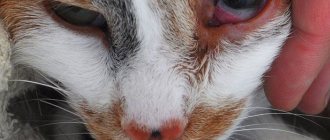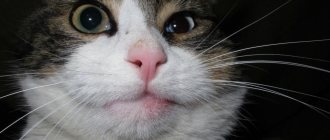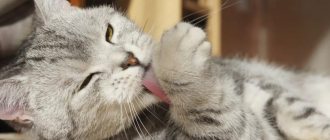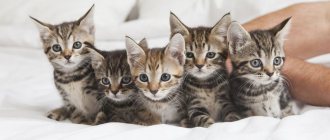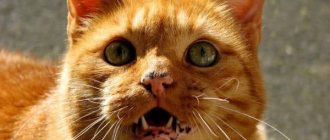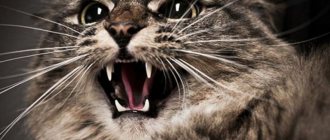It can be difficult for owners to determine the age of an animal, especially if it came into the family as an adult. Therefore, usually when cats turn gray, owners think that the animal is old or sick. However, veterinarians say that a change in color does not always indicate aging or disease.
The most telling sign of old age is poor dental health. It is by this criterion that veterinary specialists determine the approximate age of the pet. There are special tables that reflect changes in teeth over the years of life.
But can the appearance of gray hairs signal that the animal has entered old age? Or does a change in coat color indicate a problem with the body? These questions often concern responsible pet owners.
How cats go gray
It happens that colorless hairs appear even in kittens and young individuals. Sometimes whole areas of lighter fur appear on the fur. Suddenly, owners discover that their pet, which was previously monochromatic from the tips of its whiskers to the tip of its tail, now has, for example, a light-colored bib.
The animal may not have the usual silver hairs, which we usually consider gray, but brown or gray. The fur seems to fade, changing its color to a lighter and more faded color. This phenomenon is often mistaken for a sign of vitamin deficiency or dermatological problems.
Owners of older cats note that over the years, entire areas of faded fur have appeared on the animal. The fur especially changes color on the pet’s back, in the area of the muzzle and tail. It happens that by old age a pet completely changes color and becomes brown instead of black, for example.
When pets go gray
The fur can change color in a pet of any age. Sometimes this happens even in young children. But often animals actually turn gray from old age. After 7 years of age, cats develop light hairs on their back, face and ears. As a rule, this is accompanied by additional signs of aging.
In some cases, owners notice a change in the saturation of the color of the pet’s coat. Moreover, the change can affect both the entire coat and its individual sections. This phenomenon applies to both older animals and young individuals. Moreover, the color of the coat can change almost completely.
Another situation when a cat's fur turns gray is stress or illness. The reason for such changes can be a move, separation from the owner, or poor health of the pet. As a rule, in addition to the appearance of gray hair, in such situations the condition of the coat as a whole worsens.
Why does my cat have gray hair?
If gray hairs appear in a young animal, and the pet has no signs of illness, it is most likely a matter of genetics. Normally, a cat's fur color and pattern may change throughout its life. Most often, the color is formed by one and a half years, but there are cases when the color of the coat changes even later.
If gray hairs appear on an older animal, this can be considered a sign of aging. Like humans, cats experience a decrease in pigment content in their hair as they age. At the same time, it is important to take into account other criteria for the cat’s vitality: mobility, mood, condition of the skin and teeth.
Another reason for changes in fur color in a cat may be pathological processes in the animal’s body. As a rule, the situation is not limited to the appearance of gray hair and the animal experiences other alarming symptoms indicating illness. Sometimes the cause of the problem is a food allergy.
When do cats start going grey? Should the owner worry?
If we talk about age-related graying, then individual silver hairs begin to appear after about 7-8 years, but it is different for all cats. Owners of older cats often note that the pet does not turn gray with age, but becomes less bright.
Our Yosu will be 10 years old in the summer, there is no gray hair yet, in general the color does not change, with age it has become a little brighter and darker. Let's see what will happen next)
If, in general, age-related changes go unnoticed, the cat eats well and does not lose activity, then even if a few gray hairs appear, there is no need to worry.
Should I worry?
If your cat has gray hair or areas where the coat color has changed, do not panic. Observe your pet, paying special attention to the animal's appetite and activity level. If the cat eats and plays with pleasure, most likely, the appearance of gray hair is a natural process.
Changes in coat color often occur after the summer period, when the animal spent a lot of time outdoors during a country holiday. This symptom does not pose a big threat to the health of the animal, but in the future it is better to think about limiting walks during the hottest hours.
Alarm bells should be a cause for concern. If the animal has become lethargic, has lost its appetite and the cat prefers to sleep most of the day, this, without a doubt, requires the intervention of specialists. Worry should also be caused by deterioration in the quality of wool and the appearance of tangles.
Causes of cat gray hair
As stated above, this is not always a consequence of age-related changes.
Diseases
Sometimes, after undergoing operations or serious illnesses, cats develop gray hairs or entire areas of gray hair.
Poor nutrition
Melanin is responsible for color and color saturation. With a lack of amino acids, copper and macroelements, pigment production decreases, in which case not only gray areas of the coat appear, but the entire coat becomes faded.
Stress
In this way, cats are similar to people. With strong excitement, they can begin to turn gray, and stress can be provoked by either a banal fright or moving, or a long absence of the owner.
Old age
Age, of course, also causes changes in coat color, but it’s different for everyone. Some cats remain bright into old age, others become faded, and others turn gray, like people.
Source
What to do if your cat turns gray
If a cat's fur has turned gray and signs of a painful condition have appeared, owners should not postpone a visit to a specialist. With the Petstory app, you can get online advice from a certified veterinarian.
Without leaving your home, you will learn about the possible causes of gray hairs in an animal and, if necessary, draw up a plan for examining your cat with your doctor. Your veterinarian will help assess the severity of symptoms and inform you what tests and investigations you need to start treatment with.
If the cause of coat problems is an incorrect diet, using the Petstory app you can get advice on changing food, prescribing special supplements to improve the condition of the coat, and also learn about treating allergies.
Download the specialized application for pet owners Petstory on the IOS and Android platforms using the link – https://petstory.ru/prilozhenie-konsultacija-veterinar/.
White coat care
The nuances of caring for a snow-white pet
If you have a white cat or dog, your knowledge of care needs to be expanded.
Snow-white pets are more prone to allergic reactions and dermatitis, more sensitive to changes in diet, and any, even the most minor, dirt on their coat is immediately noticeable.
According to many, white color is the most spectacular. It always attracts attention and evokes rave reviews. However, it is also the most difficult to care for. But don’t rush to get upset! The main thing is to learn a few rules, and then everything will be fine with your pet’s fur! Here they are.
- Remove dirt from wool promptly
If on a dark pet you may not notice dust, then on a snow-white pet any dirt is like a warning light. Once a cat crawls under the sofa, or a dog takes a walk in slushy weather, not a trace will remain of the virgin whiteness!
It is better to remove any dirt from the fur as quickly as possible: the white coat quickly loses its appearance. How to do this depends on the degree of contamination. Sometimes just brushing off the dust with a damp brush is enough, and sometimes a full bath is required.
How to wash a white dog and cat?
Remember that snow-white pets are more prone to allergies than their counterparts? And now another news! Unsuitable bathing products can not only lead to skin problems, but also worsen the color: make it faded and cause tints. Therefore, you need to choose shampoos and conditioners very carefully.
Give preference to professional products without aggressive components, designed specifically for white dogs and cats.
Examples include whitening and lightening shampoos ISB Traditional Line Dianonds, Bio-Groom Super White Shampoo, 1 All Systems Whitening Shampoo, 1 All Systems Lightening Shampoo, shampoos and conditioners to eliminate yellowness in wool ISB Traditional Line Cristal Clean.
- Perform grooming procedures in a timely manner
Grooming is the key to a healthy and well-groomed pet, especially a snow-white one! Brush your pet regularly, do not skip haircuts and trimming. Renewing the coat is an important step to maintaining a snow-white color.
- Maintain a proper diet
Why does a white dog's fur turn pink? Why does a white cat's fur turn yellow? In many cases, the cause is an unbalanced diet.
If the acid balance in the body is disturbed, shades may appear on the coat. But don't worry: as soon as you start feeding your pet correctly, the coat will become monochromatic again.
What to feed a white dog and cat?
Experts recommend choosing super-premium balanced dry food: they have an ideal composition. The pet will receive everything it needs every day. There is only one “but”. Even the best food will be powerless if the owner ignores the feeding norm and, along with the ready-made diet, treats the pet with delicacies from the table.
Be careful, stick to one line of food, and if you want to pamper your pet with something appetizing, choose balanced treats specifically for dogs and cats.
- Monitor your pet's health regularly
Changes in coat color may indicate internal diseases. To protect your pet and yourself from unpleasant surprises, keep his health under control. Contact a veterinarian not only when there is a problem, but also for preventative purposes. And, of course, do not skip scheduled vaccinations and parasite treatments.
- Be constant
Healthy snow-white coat is the result of regular comprehensive care. You can’t give your pet “good” food today and “bad” food tomorrow, or wash it with one product or another.
Purchase suitable care products and suitable food as soon as possible and do not change them unless absolutely necessary. Work out a care plan and follow it. Not only the quality of color, but also the quality of life of your pet as a whole depends on this.
How to quickly bleach wool?
Usually this question plagues owners on the eve of a breed show. Dull coat and different shades of color are a common reason for low scores in the ring, and in some cases, disqualification.
Preparations for the exhibition need to begin several weeks in advance. Wash your pet with a professional whitening or brightening shampoo and apply conditioner to enhance the color. There is another way - right at the show, apply a special powder to the wool to brighten the white color (such as Show Tech).
After the exhibition, be sure to bathe your pet to remove all cosmetics from it.
Remember, snow-white fur was and remains the result of regular proper feeding and care of the pet. Any problems with the coat are a sign that something is wrong with the body. Once the cause is ruled out, the coat will return to white. Don't procrastinate: fix the problem, not the symptoms.
Love your pets and let their color be impeccable!
Diagnostic methods
To make the correct diagnosis
For your “yellowed” pet, the veterinarian will definitely interview you in detail about the cat’s condition, nutrition, and behavior. Then he will prescribe laboratory tests such as blood biochemistry, blood sugar, coagulogram, general blood test, tests for viral infections, toxoplasmosis, parasitic infestations, and urinalysis. An ultrasound and x-ray may be necessary. Sometimes a liver biopsy is required. Thanks to these tests, the doctor will reveal where the “culprit” of jaundice is hiding and determine the disease. Having made a prompt diagnosis, a veterinarian will most likely be able to cure jaundice in a cat.
Causes of graying
Contrary to another popular belief, gray hair does not foretell the imminent death of a pet. The matter may be a genetic predisposition, and not a violation of mineral metabolism and the functioning of internal organs. Even if a cat turns gray early, while remaining cheerful and healthy in appearance, most likely this is a manifestation of the individual characteristics of the body, heredity or side effects of the breed.
Date of publication: 09/12/2019
It can be difficult for owners to determine the age of an animal, especially if it came into the family as an adult. Therefore, usually when cats turn gray, owners think that the animal is old or sick. However, veterinarians say that a change in color does not always indicate aging or disease.
The most telling sign of old age is poor dental health. It is by this criterion that veterinary specialists determine the approximate age of the pet. There are special tables that reflect changes in teeth over the years of life.
But can the appearance of gray hairs signal that the animal has entered old age? Or does a change in coat color indicate a problem with the body? These questions often concern responsible pet owners.
Where does a black cat get white patches?
Which cats do you see more often: black cats or black cats with white markings? Of course, there are much more spotted cats in the world than their relatives with pure black color. Perhaps the most varied combination of two colors - it can be a tuft of snow-white hairs on the top or tail, and sideburns, and socks, and ties. Black and white can perform equally, there may be more white.
The variety of patterns on monochrome cats is so great that it is difficult to find two beauties with exactly the same pattern of spots. But how does one explain the fact that there are more black and white cats?
Such an unequal distribution is evidence of far from the happiest period in the life of cats - a time when they were destroyed in the hundreds just because nature colored their fur one color.
Black cats were revered as sacred by the Phoenicians - they brought several animals from Egypt to the Mediterranean countries, where they quickly spread and took their rightful place among the hearths of rural and urban residents. It was black cats that initially gained popularity among owners in Europe - thanks to their natural camouflage, they are practically invisible in the dark, which allowed small predators to successfully exterminate armies of rats and mice in their owners' barns.
But in European countries the Christian Church began to gain strength, and a period of struggle against witches and “satanic spawn” began. Not only sorcerers and witches ended up at the fires, but also their “minions,” black cats.
Every year, the church, in honor of St. John's Day, organized the ceremonial burning of hundreds of unfortunate animals, which were searched throughout the area and mercilessly thrown into the fire. The cats screamed heart-rendingly as they perished in the flames, and these sounds seemed to the inquisitors to be the screams of demons falling into hell.
It was believed that real devilish servants should be exclusively black; even a white hair in a cat’s skin was considered a sign of God, and was not touched.
So there were fewer and fewer black cats, and more and more of their spotted brothers. In this case, the church, without knowing it, became a breeder and changed the course of cat history for centuries.
In the 17th century, the inquisitorial passions subsided, and religious fanatics left the animals alone, but the troubles of black cats did not end there. Now myths have appeared about the magical and healing properties of various parts of the ill-fated cat. For example, to protect all family members from illness and weakness, the tail of a black cat was buried in the ground under the threshold.
There were also various absurd recipes using cat parts that people of that time used. Here, for example, are the recommendations for the treatment of blindness and other eye diseases given by the English naturalist Edward Topsell in 1658: “Take the head of a black cat so that there is not a single light hair, burn it so that only powder remains. Put the powder in an earthenware bowl and sprinkle it into the eyes three times a day using a bird's feather."
This is how one misfortune came to replace another - after centuries of religious persecution, the black cat suddenly turned out to be a valuable medical product for quack doctors.
After so many years of killing innocent animals, it is not surprising that next to us more often live the descendants of the owners of saving spots, passed on by inheritance. And only occasionally among ordinary outbred cats are the great-great-grandchildren of black cats who miraculously escaped execution.
Now the presence of white hairs in black color is recognized by some systems as a color defect, and selection has turned in the opposite direction. Only pedigree cats that have a pure color without a single white hair can continue the breed. But, despite all the efforts of breeders, treacherous “patches” even after centuries appear on the skins of black cats, as if trying to save them from human stupidity.
“Gray” kittens were born to a black cat! And suddenly their fur changed color for a surprising reason...
This story is about a charming black cat who gave birth to seven kittens. And these babies are the most unusual of all that you have ever seen, because instead of the usual color they are “wearing” silver coats!
Or rather, they were dressed. Because as the kittens grew, the color of their fur changed.)
It all started nine months ago when a rescue group in Los Angeles found a cat in desperate need of help.
“The owner of a mother cat contacted us after her cat ran away and became pregnant ,” said Jacqueline DeAmore, co-founder of Friends for Life RescueNetwork.
Jacqueline offered to take the animal because her owners could not afford to keep a large number of cats.
In April 2020, the cat gave birth to seven adorable kittens with silver (gray) fur. This phenomenon is known as the "fever coat" . The mother cat most likely had an infection or stress during pregnancy, which affected the color of the fur.
But the most important thing is that all the babies were healthy - the color of their coat did not affect their well-being.
“As we age, white hair falls out and its true color begins to show ,” Jacqueline added.
The kittens kept asking for milk, so the mother did not have much free time - it was taken up by caring for her beloved children.
Tiny Ben had the lightest coat when he was born. Later it turned out that the adorable baby would be striped.)
Bright stripes began to stand out more and more on his body as he grew older.
And this baby's name is Penguin. The photo was taken a couple of weeks after birth.
He has been here for about a month now.
The kitten, named Venom, was born with a white body but black fur covering his head and paws.
As he got older, the light fur disappeared. Eventually he turned into a magnificent little panther.)
“All the newborns were boys - Magneto, Venom, Joker, Penguin, Lex Luthor, Bane and Riddler,” the volunteers said.
When the babies were five weeks old, the noble silver coat completely disappeared, and people could see their true color.
“All the kittens were adopted, and one of them, Joker, stayed with me. He was my personal assistant for three months,” Jacqueline said.
The kittens turned out to be extremely pleasant and affectionate.)
“Mom is amazing too! Now she has recovered quite well (previously the cat was very thin due to feeding seven kittens),” says Jacqueline.
A few months after they were born, their beautiful natural colors had completely finished developing!
Amazing beauties!
Have you ever met “gray-haired” animals?)
By the way, people enjoyed the beautiful fur of these kittens, but they didn’t want to take the three brothers for a long time...
Liked? Be sure to follow us on , , Zen and
Source
More interesting stories:
- The golden child lived in a bag of garbage for 10 years! Its owners called rescuers out of despair...
- The dog brought it “in the hem”, but the owner was not embarrassed, but touched... Look how it was!
- They found a chip with the owner's phone on a stray baby... But he said that the chips were mixed up! And then fate gave the girl a family with a house by the sea)


